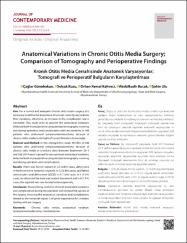Anatomical Variations in Chronic Otitis Media Surgery; Comparison of Tomography and Perioperative Findings
Citation
Günebakan Ç. , Kuzu S. , Kahveci O. K. , Bucak A. , Ulu Ş. Anatomical Variations in Chronic Otitis Media Surgery; Comparison of Tomography and Perioperative Findings. J Contemp Med. 2022; 12(1): 6-9.Abstract
Aim: For a correct and adequate chronic otitis media surgery, it is necessary to correctly define the anatomical structures and to know their possible variations, otherwise, an increase in the complication rate is inevitable. This study aims to present the anatomical variations detected both in preoperative computerized tomography scanning and during operation, and complication rates encountered in 308 patients who underwent tympanomastoidectomy due to chronic otitis media in the light of current literature knowledge. Materials and Methods: In this retrospective study, the files of 308 patients who underwent tympanomastoidectomy due to chronic otitis media in a tertiary clinic between September 2011 and July 2019 were scanned for encountered anatomical variations detected both in preoperative computerized tomography scanning and during operation and complications. Results: There was Körner septum in 12 (3.8%) cases, dehiscence in the facial nerve tympanic segment in 12 (3.8%) cases, and lateral semicircular canal dehiscence (LSCD) in 4 (1.3%) cases. In 4 (1.3%) cases, it was observed that the dura was located downward and in 6 (1.9%) cases, the sigmoid vein was located anterosuperiorly. Conclusion: Always being careful in terms of anatomical variations and possible complications during the operation will increase the success of the surgery. Knowing the anatomical variations and complications related to the temporal region is of great importance for clinicians dealing with ear surgery.
















